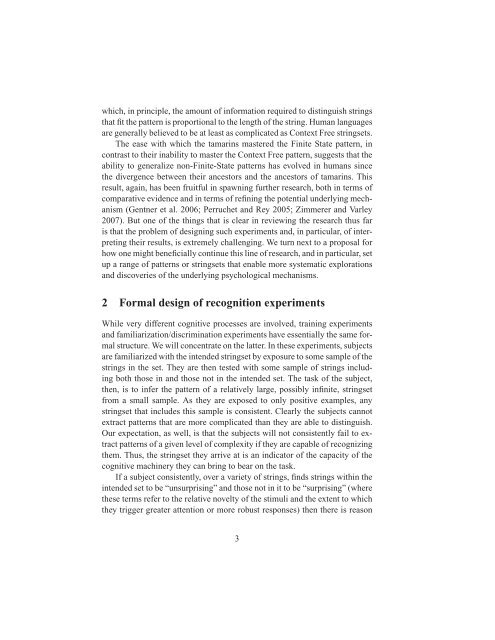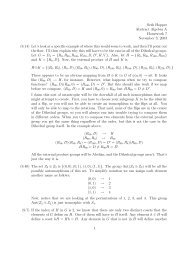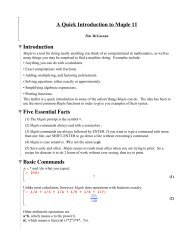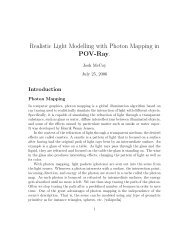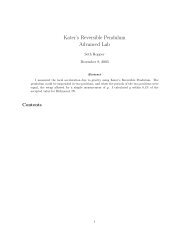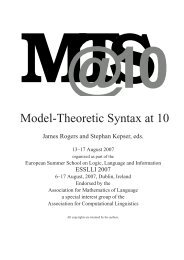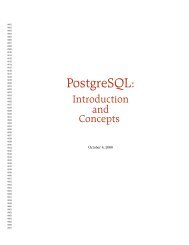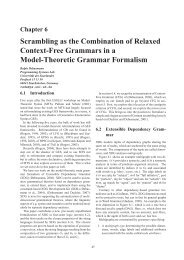The Use of Formal Language Theory in Studies of Artificial - CiteSeerX
The Use of Formal Language Theory in Studies of Artificial - CiteSeerX
The Use of Formal Language Theory in Studies of Artificial - CiteSeerX
You also want an ePaper? Increase the reach of your titles
YUMPU automatically turns print PDFs into web optimized ePapers that Google loves.
which, <strong>in</strong> pr<strong>in</strong>ciple, the amount <strong>of</strong> <strong>in</strong>formation required to dist<strong>in</strong>guish str<strong>in</strong>gsthat fit the pattern is proportional to the length <strong>of</strong> the str<strong>in</strong>g. Human languagesare generally believed to be at least as complicated as Context Free str<strong>in</strong>gsets.<strong>The</strong> ease with which the tamar<strong>in</strong>s mastered the F<strong>in</strong>ite State pattern, <strong>in</strong>contrast to their <strong>in</strong>ability to master the Context Free pattern, suggests that theability to generalize non-F<strong>in</strong>ite-State patterns has evolved <strong>in</strong> humans s<strong>in</strong>cethe divergence between their ancestors and the ancestors <strong>of</strong> tamar<strong>in</strong>s. Thisresult, aga<strong>in</strong>, has been fruitful <strong>in</strong> spawn<strong>in</strong>g further research, both <strong>in</strong> terms <strong>of</strong>comparative evidence and <strong>in</strong> terms <strong>of</strong> ref<strong>in</strong><strong>in</strong>g the potential underly<strong>in</strong>g mechanism(Gentner et al. 2006; Perruchet and Rey 2005; Zimmerer and Varley2007). But one <strong>of</strong> the th<strong>in</strong>gs that is clear <strong>in</strong> review<strong>in</strong>g the research thus faris that the problem <strong>of</strong> design<strong>in</strong>g such experiments and, <strong>in</strong> particular, <strong>of</strong> <strong>in</strong>terpret<strong>in</strong>gtheir results, is extremely challeng<strong>in</strong>g. We turn next to a proposal forhow one might beneficially cont<strong>in</strong>ue this l<strong>in</strong>e <strong>of</strong> research, and <strong>in</strong> particular, setup a range <strong>of</strong> patterns or str<strong>in</strong>gsets that enable more systematic explorationsand discoveries <strong>of</strong> the underly<strong>in</strong>g psychological mechanisms.2 <strong>Formal</strong> design <strong>of</strong> recognition experimentsWhile very different cognitive processes are <strong>in</strong>volved, tra<strong>in</strong><strong>in</strong>g experimentsand familiarization/discrim<strong>in</strong>ation experiments have essentially the same formalstructure. We will concentrate on the latter. In these experiments, subjectsare familiarized with the <strong>in</strong>tended str<strong>in</strong>gset by exposure to some sample <strong>of</strong> thestr<strong>in</strong>gs <strong>in</strong> the set. <strong>The</strong>y are then tested with some sample <strong>of</strong> str<strong>in</strong>gs <strong>in</strong>clud<strong>in</strong>gboth those <strong>in</strong> and those not <strong>in</strong> the <strong>in</strong>tended set. <strong>The</strong> task <strong>of</strong> the subject,then, is to <strong>in</strong>fer the pattern <strong>of</strong> a relatively large, possibly <strong>in</strong>f<strong>in</strong>ite, str<strong>in</strong>gsetfrom a small sample. As they are exposed to only positive examples, anystr<strong>in</strong>gset that <strong>in</strong>cludes this sample is consistent. Clearly the subjects cannotextract patterns that are more complicated than they are able to dist<strong>in</strong>guish.Our expectation, as well, is that the subjects will not consistently fail to extractpatterns <strong>of</strong> a given level <strong>of</strong> complexity if they are capable <strong>of</strong> recogniz<strong>in</strong>gthem. Thus, the str<strong>in</strong>gset they arrive at is an <strong>in</strong>dicator <strong>of</strong> the capacity <strong>of</strong> thecognitive mach<strong>in</strong>ery they can br<strong>in</strong>g to bear on the task.If a subject consistently, over a variety <strong>of</strong> str<strong>in</strong>gs, f<strong>in</strong>ds str<strong>in</strong>gs with<strong>in</strong> the<strong>in</strong>tended set to be “unsurpris<strong>in</strong>g” and those not <strong>in</strong> it to be “surpris<strong>in</strong>g” (wherethese terms refer to the relative novelty <strong>of</strong> the stimuli and the extent to whichthey trigger greater attention or more robust responses) then there is reason3


